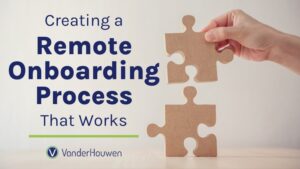Creating a Remote Onboarding Process That Works
The employment landscape has shifted since COVID-19 shelter-in-place orders began. Entire organizations have been disrupted and are suddenly working from home, which means onboarding has become trickier for companies without a process in place for hiring remotely. Regardless of the pandemic, your company still has important work to do to thrive and grow, and hiring delays will slow you down. With some reflection, an open mind, and lots of feedback, you can create a remote onboarding workflow that transforms your hiring and keeps you moving forward.
How to get started
- Review your current onboarding process: To create a successful remote onboarding process, evaluate your current onsite processes. Look at each step new hires take during onboarding. What is the purpose of that action? Are they learning about the products you sell or an overview of a tool they’ll be using? What do they need to know by the end of onboarding to succeed in their new role? Once you see each step through that lens you can adjust action items to be performed remotely.
- Check your tech: Stay connected alongside your teams with tools like Microsoft Teams, Slack, or Discord. To keep your team on track, use project management tools like Trello, Monday or Asana to build digital Kanban boards. You can even make individual threads within your chosen platform specifically for new hire groups to chat about what they're learning and problem-solve together. Take your virtual communications to the next level by video chatting on platforms like Teams, Zoom, or Google Hangouts. Utilize online signing platforms like DocuSign to get the candidate’s signature on offer letters or internal documentation. You’ve even got options for benefits administration like Paylocity!
- Check your hardware: Drop off or ship the laptop and other equipment your new employee will need to be successful. Check in with them prior to their start date–ensure they have everything necessary to perform their job and their workspace is ready. If needed, schedule a video chat between the new hire and the IT department to add any required software to the computer, to ensure login credentials work, and to confirm any peripheral equipment like headsets or other special tools are functioning properly.
- Keep in touch before they begin: Send engaging emails showcasing your company culture and what they can expect before they start. Give them a chance to get to know their new company, accomplish new hire tasks, and finish paperwork ahead of their start date. That way they can jump right into acclimating to their new team on day one! Also, if remote onboarding is new for your company, it’s okay to share this with the new employee. Prepare them to expect to be part of the feedback and learning process to make improvements along the way. Compare market rate salary ranges for over 100 job titles at companies of all sizes across the Portland Metro area. Everything you need to determine hiring budgets or negotiate a job offer is right here!
An Inclusive Remote Culture
- Hire in multiples: Are you worried about losing part of your culture that developed through high-touch, in-person interactions in the office? Don’t be! You can build a strong culture virtually. Cohorts of new hires can help each other out from the beginning. You can even create dedicated chats or channels in Slack or Microsoft Teams for the new hires to get to know each other better. Host breakout sessions within the training curriculum so you can dive deeper, answer specific questions, and facilitate a discussion on what they’ve learned and tips they might share.
- Give each new hire a mentor/buddy: If you're hiring an individual instead of a cohort, match them with someone that can be their go-to person for the first few weeks. A new hire buddy can be a sounding board for questions, share context where appropriate, and provide hands-on support for any snags in training. They are the first person your new hire will go to when there are issues and the first person they'll feel connected to.
- Schedule activities: A group video chat to play a team bonding game or a fun round of trivia about your organization will add some levity to onboarding without taking away from training. Take them on a virtual tour of the office (if possible right now) and invite them to video chats with higher-ups so they can put faces to names. Host a virtual lunch with their new team or an informal coffee break with colleagues so they can feel included and get to know the larger team.
- Embrace Remote Work: Everyone is working from home right now due to the pandemic so whether it’s a barking dog or loud neighbors, distractions are bound to come up. Some companies have a rule that if someone's loved ones wander into the video frame of an informal meeting, they’re introduced to the chat. This could even extend to pets if you’re looking for a little lighthearted fun! Make sure alternate modes of communication are made available, too. Provide internal staff with a direct line or cell phone directory, or a conference line to call in the case of technical difficulties.
- Chat often: When onboarding onsite employees, you can check in with your new hire by simply walking down the hallway. Because that's not possible when you're remote, find new ways to check-in and stay in touch. Whether you’re their direct contact in the company or you’re just popping in to check on their progress, IM, email, or video chat can replace those brief interactions while still showing support. When checking in, don’t just talk about work! Be transparent and try connecting with your new hires on a personal level.
Onboarding Doesn’t Stop on Day 1
- Individual 30/60/90 day check-ins: Each new hire will differ in how quickly they learn new workflows, the new skills they need to acquire, and what their role will require of them overall. Your onboarding plans will adjust with each hire, but you should have a good idea of what you want them to accomplish and when. Establish a list of action items and goals for each milestone but be willing to adjust as necessary if you find they need more time to train.
- Don’t rush the process: Onboarding doesn’t have to be quick and dirty–in fact, we recommend spreading it out over multiple days or their first few weeks. Create breathing room in their first week so you can spend time reaffirming your company's mission and values, answering any questions they may have, and setting them up for success without feeling rushed. Not to mention that breaking up the training material gives new hires a greater chance to fully absorb what they're learning. If hiring in groups, giving them more time to settle in means everyone can connect one-on-one with the hiring/welcoming team, their hiring cohort, and other employees.
- Be patient: Hiccups will happen, the software will freeze, the webpage won’t load properly, or the headset sound isn’t quite right. It happens. Handle each situation with grace and keep moving forward. With so much happening in the world focusing can be difficult, so approach every step of the onboarding process with empathy. Give new hires space to complete their tasks without micromanaging.
- Solicit feedback then make it happen: When you’re finished onboarding a new employee, solicit honest feedback about the process. What parts went smoothly and what was more confusing to push through? Feedback can best serve you if it’s immediately put into action, so take it in and get started on changes ASAP. Fine-tuning the process will make future remote new hires a breeze! Who knows, in the future you may be able to blend the best elements of remote and in-person onboarding to take your candidate experience to the next level!
Now that your remote onboarding process is in place, let’s kickstart your hiring to secure top talent now! Contact us for a free consultation on your remote hiring needs.































































































































